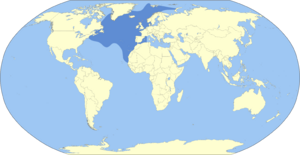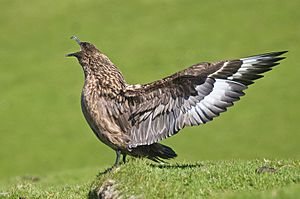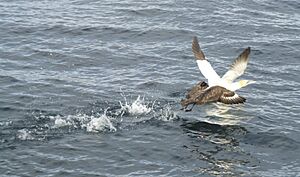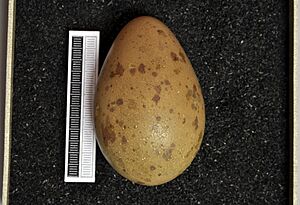Great skua facts for kids
Quick facts for kids Great skua |
|
|---|---|
 |
|
| Conservation status | |
| Scientific classification | |
| Genus: |
Stercorarius
|
| Species: |
skua
|
 |
|
| Synonyms | |
|
Catharacta skua |
|
The great skua (Stercorarius skua), also called the bonxie in Britain, is a big seabird. It belongs to the skua family. This bird is about the same size as a herring gull. Great skuas mostly eat fish they catch from the sea. They also take food from other birds.
Contents
About the Great Skua's Name
The great skua was first described in 1764. This happened in the Faroe Islands and Iceland. A Danish scientist named Morten Thrane Brünnich gave it the name Catharacta skua. Today, it is part of the Stercorarius group of birds.
The name "skua" comes from the Faroese word skúvur. This is the only bird name from the Faroe Islands used widely today. In Britain, people sometimes call it "bonxie." This name comes from the Shetland Islands and has Norse roots. The name Stercorarius is Latin for "of dung." People once thought the food skuas stole was waste.
What Does a Great Skua Look Like?
Great skuas are large birds. They are about 50 to 58 centimeters (20 to 23 inches) long. Their wings can spread wide, from 125 to 140 centimeters (49 to 55 inches). Males weigh around 1.27 kilograms (2.8 pounds). Females are a bit heavier, about 1.41 kilograms (3.1 pounds).
Adult skuas are streaky grey-brown with a black cap. Young skuas are warmer brown and do not have streaks. They have a short, blunt tail. They are also very strong flyers. Their call sounds like a harsh hah-hah-hah-hah. They can also make quacking and croaking noises.
It is easy to tell a great skua from other skuas in the North Atlantic. Its large size, broad chest, and white flashes on its wings stand out. From a distance, it might even look like a common buzzard.
Where Did Great Skuas Come From?
Scientists have studied the genes of great skuas. They found surprising links between great skuas and pomarine skuas. Many experts now think the great skua might have come from a mix of different skua types. This could have happened when birds traveled far from their usual homes.
Great Skua Reproduction and Breeding Habits

Great skuas breed in Iceland, Norway, and the Faroe Islands. They also breed on Scottish islands. Some even nest on mainland Scotland and in northwest Ireland. They build their nests on coastal moorland and rocky islands.
They usually lay two spotted olive-brown eggs. The eggs are placed in nests lined with grass. Like other skuas, they protect their nests fiercely. If a person or animal gets too close, the skua will fly at their head. This can be scary, even though the bird cannot cause serious harm.
Great skuas are migratory birds. They spend winter at sea in the Atlantic Ocean. They often travel to North American waters. Sometimes, they even visit Mediterranean countries like Turkey.
What Do Great Skuas Eat?
Great skuas eat many different things. Their diet includes fish, other birds, eggs, and dead animals. They also eat rodents, rabbits, and sometimes berries. There have even been reports of them preying on lambs and young ponies. A common food source for them is fish left behind by fishing boats.

Skuas often get fish by stealing from other birds. They will rob gulls, terns, and even large northern gannets. They also directly attack and kill other seabirds, even ones as big as herring gulls. This behavior is called kleptoparasitism, which means stealing food.
Great skuas use their strength to get food. A common trick is to fly up to a gannet in the air. They grab the gannet by its wing, making it fall into the sea. Then, the skua attacks the gannet until it drops its catch. Because of their size and aggressive nature, great skuas have few natural enemies. Young skuas might be caught by rats, cats, or Arctic foxes. But healthy adult skuas are usually only threatened by large birds of prey, like the golden eagle or white-tailed eagle. Sometimes, at sea, an orca might also be a threat.
Great Skua: An Apex Predator
The great skua is a top predator in the sky. It is an aggressive "pirate" of the seas. It deliberately bothers birds as big as gannets to steal their meals. It also hunts and eats smaller birds, such as puffins.
Great skuas show little fear of humans. If you get too close to their nest, the angry adults will repeatedly dive-bomb you. In 2007, scientists studied skuas on St Kilda, Scotland. They saw the skuas hunting Leach's storm petrels at night. This was a surprising and unusual hunting method for a seabird.
Images for kids
-
At Handa Island / Scotland










